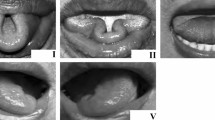Summary
In one family 43 individuals were examined. 13 of them showed a syndrome as described by Hecht and Beals, with the features:
-
1.
Inability to open the mouth fully.
-
2.
Flexion of the fingers in attempts to extend the hand.
-
3.
Shortening of the hamstring muscles.
-
4.
Shortening of leg muscles.
I could establish the following new phenomena:
-
a)
An abnormal ligament extending from the maxilla to the mandibula.
-
b)
A hardened cord behind the nasolabial furrow.
-
c)
The occasional incidence of papules on these ligaments or cords.
-
d)
Quilted appearance of the face.
-
e)
In the older individuals, blepharochalasis.
It is likely for the syndrome to be bound up in some way with a general change in the connective tissue.
Zusammenfassung
In einer Sippe konnten 43 Angehörige untersucht werden, 13 von ihnen zeigten ein Syndrome, das von Hecht u. Beals (1969) beschrieben worden und durch folgende Symptome gekennzeichnet ist:
-
1.
Unfähigkeit, den Mund ganz zu öffnen.
-
2.
Beugestellung der Finger bei Streckung der Hand.
-
3.
Verkürzung der Kniebeuger am Oberschenkel.
-
4.
Verkürzung der Wadenmuskeln.
Zusätzlich konnten folgende neue Symptome festgestellt werden:
-
a)
Ein abnormes Ligament, das von der Maxilla zur Mandibula zieht.
-
b)
Eine strangförmige, offenbar bindegewebige Verstärkung hinter der Nasolabialfurche.
-
c)
Gelegentliches Vorkommen von knötchenförmigen Bildungen in diesen Strängen oder Ligamenten.
-
d)
Polsterung der Wangen, die sich watteartig anfühlt.
-
e)
Abnorme Lidhauterschlaffung bei älteren Merkmalsträgern.
Man kann vermuten, daß dem Syndrome eine allgemeine Anomalie des Bindegewebes zugrunde liegt.
Similar content being viewed by others
References
Ashley, L. M.: The inheritance of streblomicrodactyly. J. Hered. 38, 93–96 (1947).
Hecht, F., Beals, R. K.: Birth Defects. Original Article Series 5, 96–98 (1969).
Hefner, R. A.: Crooked little fingers (minor streblomicrodactyly). J. Hered. 32, 37–38 (1941).
Parish, J. G., Horn, D. B., Thompson, M.: Familial streblodactyly with amino-aciduria. Brit. med. J. 1963 II, 1247–1250.
Smith, R. J., Kaplan, E. B.: Camptodactyly and similar atraumatic flexion deformities of the proximal interphalangeal joints of the fingers. J. Bone Jt Surg. 50-A, 1187–1203 (1968).
Wilson, R. V., Gaines, D. L., Brooks, A., Carter, H. S., Nance, W. E.: Birth Defects. Original ARticle Series 5, 99–102 (1969).
Author information
Authors and Affiliations
Rights and permissions
About this article
Cite this article
de Jong, J.G.Y. A family showing strongly reduced ability to open the mouth and limitation of some movements of the extremities. Humangenetik 13, 210–217 (1971). https://doi.org/10.1007/BF00326944
Received:
Issue Date:
DOI: https://doi.org/10.1007/BF00326944




